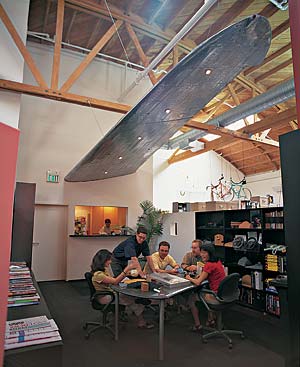Cultivating an environment in which there is a swift and easy exchange of ideas is an important part of the design process in many firms, both large and small. What may not be so obvious are strategies to foster optimal functioning and creative thinking in such an environment.

Early in their indoctrination and training, architecture students learn about studio culture. It has been a hot topic for the American Institute of Architecture Students, the Association of Collegiate Schools of Architecture, and the National Architectural Accreditation Board. Architecture schools are required to demonstrate a healthy design studio culture in order to be accredited, and criteria include encouraging “respect, engagement, and innovation among faculty and student body,” which should serve as a model of professional conduct in the future.
There is increasing recognition that a firm’s cultural environment is a critical factor not only in producing the best possible design work but also in attracting and retaining both new staff and clients. Many architectural firms are now including sections on their Web sites dedicated to describing a distinctive office culture. Their intent is to demonstrate that the firm has a climate in which excellent design can be nurtured, so they can serve as a magnet for talented people, who are in great demand at the moment. By definition, the design process involves some degree of innovation relative to a unique set of project circumstances. Since design—and its management—is the core of what most architects do, it follows that creating the environment to facilitate an innovative subculture should likewise be a main concern.
A firm’s culture, as succinctly characterized by Jean Valence, Hon. AIA, principal and director of strategic development at Symmes Maini & McKee Associates, Cambridge, Massachusetts, “encompasses its history and accomplishments, its leaders’ ambitions and goals, its definition of and criteria for excellence, its attitude about clients and staff, its traditions and lore, its mood and energy, and its balance between art and business.” In other words, a firm’s values describe its culture, and the subcultural components such as those promoting innovation, continuing education, communication, and so on, impart a distinct personality.
Strategies that support a subculture of innovation
Here are a few strategies suggested by experts to encourage innovation that might surprise you: Hire naive misfits who argue with you; encourage failure; avoid letting client input limit your vision; and fully commit to risky ventures. This is an extreme approach to fostering innovation in an otherwise relatively static office environment that was proposed by Robert I. Sutton. Writing in the Harvard Business Review in 2001, Sutton argued that fresh perspectives derive from mavericks with wildly diverse backgrounds and no preconceptions who challenge the status quo, champion their own ideas, and illuminate the metaphorical darkness.
Sutton points out that ignoring client input may seem counterintuitive, but clients can’t always imagine what’s possible. Ted Hoff, an inventor of the microprocessor, echoed that sentiment the next year, also in Harvard Business Review: “Don’t do what the customer wants; do something better.” Likewise, failure is critical to the design process—assuming the group learns from the failure—because, typically, many bad ideas must be generated to produce a terrific one. Even the bad ideas can illuminate a problem and serve as a creative trigger to its solution. IDEO, the renowned Palo Alto, California, innovation and design firm, has a saying: “Fail often to succeed sooner.”
A somewhat more tempered and time-proven model of Sutton’s dogma is embodied in the culture of the United States Navy. The role of the executive officer, or second-in-command, is historically charged with such principles as support and delegation of authority. But also implicit is the responsibility of providing alternative, even self- consciously innovative, solutions to problems that may arise in battle or in other emergency situations. Frankly opposite viewpoints from those of the commanding officer are often invited and seen as requisite components of tactical decision making. The resulting complementary tension that exists between the commanding and executive officers is considered a positive force that enriches the culture because it demands that alternative strategies must be considered. Perhaps a formalized notion of a second-in-command equivalent that would add some creative and energetic tension could be a beneficial addition to some architecture firms’ cultures, improving the underlying process and dynamic of their design teams.
The notion of a council of experts made up of senior members of a practice, as a resource that contributes to a learning environment through mentoring, supporting teams and individuals with new ideas, and sharing best practices, is a powerful cultural attribute. Moreover, tapping into a firm’s internal expertise can assist designers in understanding particular building types and technologies in an accelerated manner. James R. Brogan, AIA, senior associate principal with Kohn Pedersen Fox (KPF), describes a Web-based example of such a resource—the firmwide KPF intranet—that includes a database of valuable past project information. He says, “One can best take advantage of our internal knowledge and experience through the database and knowing who within the office worked on a particular project.”
To augment the database, KPF is planning on shortly launching an “Architectural Forum” on the intranet, which will be a “collaborative vehicle for posting questions, comments, techniques, materials issues, and so on, about specific projects to capture a running discourse on various design topics throughout the office. It will be searchable and will contain pertinent solutions and best practices through a firmwide dialogue.”

Post a comment to this article
Report Abusive Comment